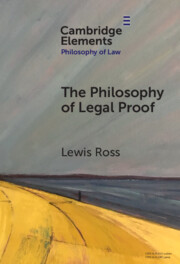8772 results
4 - Traces of Female Bhojpuri Migrants in Suriname
-
-
- Book:
- <i>Girmitiyas</i> and the Global Indian Diaspora
- Published online:
- 20 April 2024
- Print publication:
- 31 May 2024, pp 83-118
-
- Chapter
- Export citation

The Philosophy of Legal Proof
-
- Published online:
- 23 April 2024
- Print publication:
- 16 May 2024
-
- Element
- Export citation
The Ostroms on self-governance: the importance of cybernetics
-
- Journal:
- Journal of Institutional Economics / Volume 20 / 2024
- Published online by Cambridge University Press:
- 22 April 2024, e23
-
- Article
-
- You have access
- Open access
- HTML
- Export citation
Chapter 3.2 - Causes of Depression
-
-
- Book:
- Seminars in General Adult Psychiatry
- Published online:
- 04 April 2024
- Print publication:
- 18 April 2024, pp 89-107
-
- Chapter
- Export citation
Laxative use in adults with intellectual disabilities: development of prescribing guidelines
-
- Journal:
- BJPsych Open / Volume 10 / Issue 3 / May 2024
- Published online by Cambridge University Press:
- 18 April 2024, e84
-
- Article
-
- You have access
- Open access
- HTML
- Export citation
Feline Entanglements: Feminist Interspecies Care and Solidarity in a Post-Pandemic World
-
- Article
-
- You have access
- Open access
- HTML
- Export citation
The selective serotonin reuptake inhibitor sertraline alters learning from aversive reinforcements in patients with depression: evidence from a randomized controlled trial
-
- Journal:
- Psychological Medicine , First View
- Published online by Cambridge University Press:
- 17 April 2024, pp. 1-13
-
- Article
-
- You have access
- Open access
- HTML
- Export citation
Parasite populations in the brown rat Rattus norvegicus from Doha, Qatar between years: the effect of host age, sex and density
-
- Journal:
- Journal of Helminthology / Volume 79 / Issue 2 / June 2005
- Published online by Cambridge University Press:
- 12 April 2024, pp. 105-111
-
- Article
- Export citation
Changes in survival characteristics of Diplostomum spathaceum cercariae emerged from cadmium-exposed Lymnaea stagnalis
-
- Journal:
- Journal of Helminthology / Volume 79 / Issue 1 / March 2005
- Published online by Cambridge University Press:
- 12 April 2024, pp. 55-59
-
- Article
- Export citation
Metacercarial utilization of a naturally infected single species (Lymnaea peregra) snail community by Echinoparyphium recurvatum
-
- Journal:
- Journal of Helminthology / Volume 78 / Issue 1 / March 2004
- Published online by Cambridge University Press:
- 12 April 2024, pp. 51-56
-
- Article
- Export citation
Ligula intestinalis infection as a potential source of bias in the bioindication of endocrine disruption in the European chub Leuciscus cephalus
-
- Journal:
- Journal of Helminthology / Volume 79 / Issue 1 / March 2005
- Published online by Cambridge University Press:
- 12 April 2024, pp. 91-94
-
- Article
- Export citation
Influence of cadmium exposure on the incidence of first intermediate host encystment by Echinoparyphium recurvatum cercariae in Lymnaea peregra
-
- Journal:
- Journal of Helminthology / Volume 78 / Issue 4 / December 2004
- Published online by Cambridge University Press:
- 12 April 2024, pp. 329-332
-
- Article
- Export citation
Cadmium-induced cellular and immunological responses in Cyprinus carpio infected with the blood parasite, Sanguinicola inermis
-
- Journal:
- Journal of Helminthology / Volume 77 / Issue 4 / December 2003
- Published online by Cambridge University Press:
- 12 April 2024, pp. 341-350
-
- Article
- Export citation
Parasite aggregations in host populations using a reformulated negative binomial model
-
- Journal:
- Journal of Helminthology / Volume 78 / Issue 1 / March 2004
- Published online by Cambridge University Press:
- 12 April 2024, pp. 57-61
-
- Article
- Export citation
Toxicity of cadmium and zinc mixtures to the decaudized cercarial life span of Diplostomum spathaceum
-
- Journal:
- Journal of Helminthology / Volume 79 / Issue 4 / December 2005
- Published online by Cambridge University Press:
- 12 April 2024, pp. 353-359
-
- Article
- Export citation
Editorial
-
- Journal:
- Journal of Helminthology / Volume 80 / Issue 2 / June 2006
- Published online by Cambridge University Press:
- 12 April 2024, p. 91
-
- Article
-
- You have access
- Export citation
Genomic variability within laboratory and wild isolates of the trichostrongyle mouse nematode Heligmosomoides polygyrus
-
- Journal:
- Journal of Helminthology / Volume 74 / Issue 3 / September 2000
- Published online by Cambridge University Press:
- 12 April 2024, pp. 195-201
-
- Article
- Export citation
Patterns of infracommunity species richness in eels, Anguilla anguilla
-
- Journal:
- Journal of Helminthology / Volume 78 / Issue 2 / June 2004
- Published online by Cambridge University Press:
- 12 April 2024, pp. 141-146
-
- Article
- Export citation
Monospecific helminth and arthropod infections in an urban population of brown rats from Doha, Qatar
-
- Journal:
- Journal of Helminthology / Volume 75 / Issue 4 / December 2001
- Published online by Cambridge University Press:
- 12 April 2024, pp. 313-320
-
- Article
- Export citation
The role of Bithynia tentaculata in the transmission of larval digeneans from a gravel pit in the Lower Thames Valley
-
- Journal:
- Journal of Helminthology / Volume 78 / Issue 2 / June 2004
- Published online by Cambridge University Press:
- 12 April 2024, pp. 129-135
-
- Article
- Export citation



